|
|
GammaTech DURABOOK CA10
Attractively priced semi-rugged Intel Atom-powered 10.1-inch tablet computer with good connectivity and numerous customization options for field deployments
(by Conrad H. Blickenstorfer; photography by Carol Cotton)
Early 2013, GammaTech Computer Corporation, which is the North American/Latin American sales and marketing arm of Taiwanese Twinhead, introduced the Durabook CA10 semi-rugged ultra-mobile tablet PC. It's a 10.1-inch design geared towards utility workers, public safety employees, fleet managers and other mobile-oriented service industries. In this article, RuggedPCReview takes a detailed look at this intriguing and very competitively priced tablet computer.
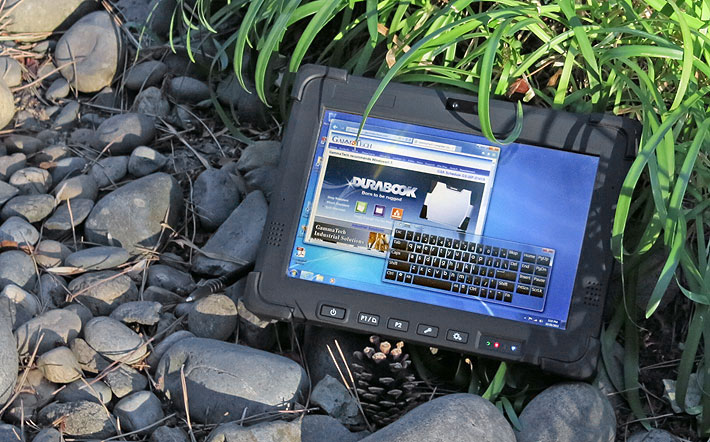
With consumer tablets selling in the tens and hundreds of millions, companies like GammaTech find themselves guessing how to best fill the rapidly growing demand for somewhat more rugged tablets with just the right combination of price, ease-of-use, performance, size, weight and features. Definitely not an easy task.
Among the issues faced by makers of rugged tablets are the choice of operating system, the degree of ruggedness, and the proper price point so as to be competitive. All are challenging and can make the difference between success and failure:
- On the operating system side, the choice is between Microsoft Windows, which has never been truly optimized for tablets but offers continuity and legacy support, and Android, which dominates the smartphone market and is the primary challenger to Apple in the media tablet market.
- As for ruggedness, the very clear trend in consumer tablets is as thin and light as possible, and that's exactly what rugged tablets cannot be if they are to provide the toughness and versatility required for many jobs.
- On the cost side, due to ruggedization and much lower sales volumes, vertical/industrial market computing products have traditionally been considerably more expensive than consumer products. Price erosion in consumer products is now leading to additional price pressure on rugged market products.
Given the above, manufacturers of rugged computing equipment see greater opportunity but are also faced with greater challenges than ever before. So how did GammaTech position itself with the Durabook CA10?
The Durabook CA10 — overview
Overall, the Durabook CA10 is more an evolved version of a traditional vertical market Windows Tablet PC than a ruggedized implementation of a consumer media tablet. GammaTech stayed with Windows rather than trying Android, which meant using a processor that could power Windows at an acceptable pace without pricing itself out of the market with an expensive Intel Core processor. 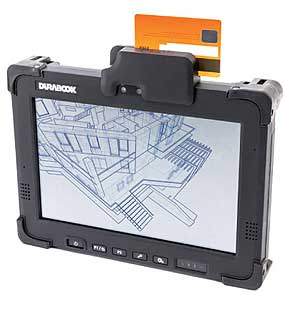
On the other hand, Gammatech went with a 10.1-inch screen and wide-format 1280 x 800 pixel resolution—both more modern than the typical 800 x 600 or 1024 x 768 on 8.4-inch screens that were the norm for rugged tablets for many years. And while GammaTech didn't go with the projected capacitive touchscreen technology and its effortless tapping, panning, zooming and pinching, the resistive touch screen of the CA10 does support multi-touch and works surprisingly well.
In terms of looks and design, the CA10 (which supports a number of interesting options, such as a bolt-on mag stripe reader shown in the picture to the right) is modified old-school, i.e. it looks like a serious PC tool for the job rather than a sleek, slender slate off glass and metal. Nothing wrong with that. The CA10 measures 10.6 x 7.8 inches, which is about an inch longer than an iPad but not much wider. Bumpers, dual batteries and an entirely different design philosophy mean it's thicker, too, than a consumer tablet, but just over an inch is still remarkably svelte by rugged computing standards. It does weigh well over three pounds, though, and that's three times the weight of an iPad Air, plus.
Design, look, and feel — purposeful utility
Below you can see the GammaTech Durabook CA10 from the top and all four sides. An internal magnesium alloy chassis means the tablet doesn't flex and twist. The body of the CA10 is a very dark matte gray, almost black. On the upper front there's a designated logo area since GammaTech machines often sell in rebadged versions. The enclosure is elegantly contoured and beveled, making for a nice design instead of just a box. The overall design also projects a purposeful tool-for-the-job look that sets it apart from the plasticky, glossy look of most consumer media tablets. The LCD is recessed into the bezel by perhaps 3/16th of an inch.This provides better display protection, but differs from the flush glass front now prevalent in almost all consumer tablets.
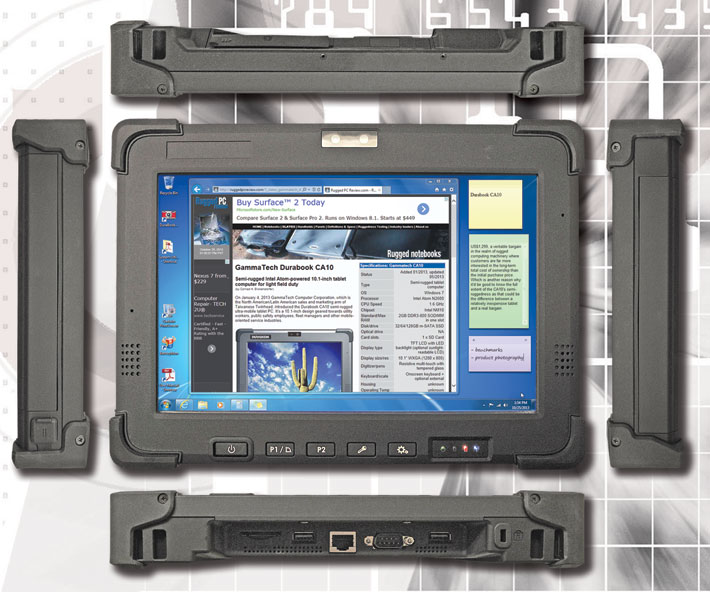
In terms of construction, the Gammatech Durabook CA10 is an almost unexpectedly complex and sophisticated design. Overall, the tablet consists of two plastic halves. Inside the front half is a very solid magnesium alloy frame on which the display is mounted. The motherboard is attached to the back half. Both halves are secured together with eight Philips screws. When disassembling the unit, take care not to damage the various wires and ribbon cables between the two halves (camera, antennae, LCD display, etc.).
Access to the interior is provided with a removable, vented back cover held in place with seven small Philips screws. But this is not just a simple plastic cover; instead, it also houses the unit's Smart Card reader and there is also a place for an optional rear-facing camera with LED illuminator (our eval unit didn't have that installed).
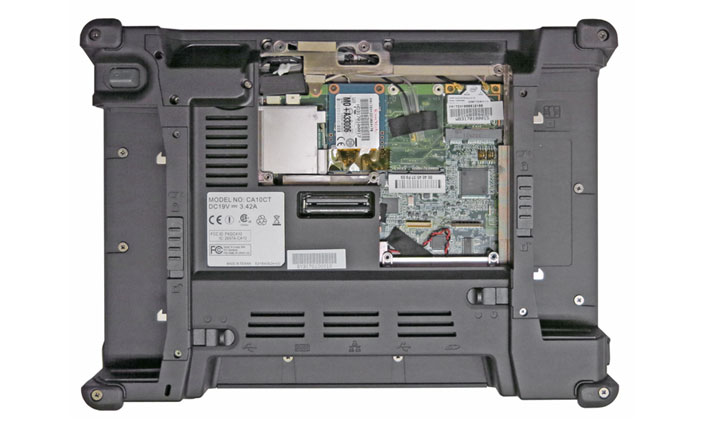
The cover further includes a metal frame that acts as a heat sink and heat exchanger. Two small rectangles of heat-conducting material press against the CA10's Intel Centrino Wireless-N 135 WiFi module (see Wireless-N 135 product page) and also the 64GB SanDisk SDSA5DK SATA-600 solid state drive with its 52-pin mini-SATA interface. Between those two is another miniPCI-e slot with room for a full-size card, probably used for optional WWAN.
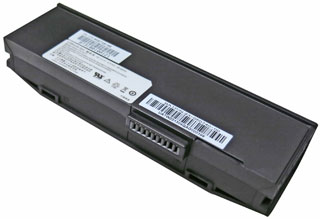 The two 11.1 Volt, 2.6Ah (28.86 watt-hour) Lithium-Ion batteries are part of the design and snap into the case of the CA10 in the left and right backside. They are securely held in place via a spring-loaded mechanism with two hooks. A total battery capacity of 57.7 watt-hours is quite generous for this type of system. GammaTech specs claim about 9 hours of battery life between charges. The two 11.1 Volt, 2.6Ah (28.86 watt-hour) Lithium-Ion batteries are part of the design and snap into the case of the CA10 in the left and right backside. They are securely held in place via a spring-loaded mechanism with two hooks. A total battery capacity of 57.7 watt-hours is quite generous for this type of system. GammaTech specs claim about 9 hours of battery life between charges.
In our testing we couldn't get our PassMark BatteryMon benchmark utility to work quite right, but did see an idle draw of around 6 watts in the Windows High performance power setting. That would validate GammaTech's nine hour claim.
Tablets generally don't excel in conventional connectivity, but the CA10 does quite well. Almost all I/O is concentrated in a downward-facing recessed area at the bottom of the tablet. You get two full-size USB 2.0 ports, an RJ45 LAN jack, and even a legacy serial port. On the other hand, no HDMI or micro-USB.
On top of the tablet, facing up, is the window for an optional integrated bar code scanner, and also a Smart Card reader slot. The slot can be protected with a hinged rubbed plug that is a bit hard to fit properly.
GammaTech offers a bolt-on MSR in addition to optional 1D/2D scanning and an RFID reader. A 1.3mp webcam is standard, but the 5mp rear camera with LED illuminator is optional.

The picture below is a close-up of the Durabook CA10's hardware controls:

From left to right, there's power; function button P1 that rotates the display clockwise in 90-degree increments, but can also be assigned to launch applications or utilities; programmable function button P2; the lock button that does a Microsoft Alt-Ctl-Del; and the Quick Menu button that provides one-tap access to various utilities and toggles. Next to it are four control LEDs (power, both batteries, and wireless).
Performance — suitable
For technology, GammaTech relies on the dual-core 1.6GHz Intel Atom N2600, probably the best general purpose Atom chip so far, and also one that's in widespread use in numerous vertical market and enterprise computing devices. Thanks to 32nm process technology and various power conservation measures, the N2600 has a maximum thermal design power of just 3.5 watts. 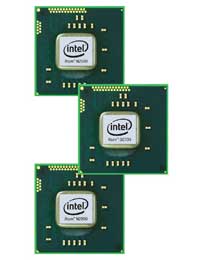 The NM10 Express chipset used in the Durabook CA10 is miserly as well, with a TDP of just 2.1 watts, making for a combined CPU/chipset maximum draw of just 5.6 watts. The NM10 Express chipset used in the Durabook CA10 is miserly as well, with a TDP of just 2.1 watts, making for a combined CPU/chipset maximum draw of just 5.6 watts.
Unlike some earlier Atom processors that weren't always up to the job, the Atom N2600 provides reasonable performance, both for computing and graphics, at reasonably low power consumption. The CA10 can be ordered with up to 2GB of DDR3 RAM, and up to 128GB of m-SATA solid state disk. SSDs can be stupidly fast and they're much less vulnerable to impact than rotating media, so good choice there. And there's also an SD card slot.
To see what kind of performance the Durabook CA10 provides with its dual-core Atom processor, we ran our standard benchmark suite, Passmark Software's PerformanceTest 6.1, that runs about 30 tests covering CPU, 2D graphics, 3D graphics, memory, and disk and then computes scores for each category and an overall PassMark score. We also ran our second benchmark suite, CrystalMark, for confirmation and additional information. For comparison and to provide an idea where the Durabook CA10 stands, we included benchmark results of three other recent 10-inch class ruggedized tablets with the same N2600 chip, one that uses the slightly faster N2800 version of the chip, and also a Core i7-based product to show how this class of Atom-powered devices compares to products based on the much more complex (and costlier) Intel Core processors.
The results are as follows:
|
GammaTech Durabook CA10 Benchmarks and Comparisons
|
|
PERFORMANCE COMPARISON
|
GammaTech
|
DAP
|
Handheld
|
MobileDemand
|
Ruggedbook
|
Winmate
|
|
Model
|
CA10
|
MT 1010
|
Algiz 10X
|
T1200
|
PC750
|
9.7
|
|
Processor Type: Intel
|
Atom
|
Atom
|
Atom
|
Core i7
|
Atom
|
Atom
|
|
Processor Model
|
N2600
|
N2600
|
N2800
|
3517UE
|
N2600
|
N2600
|
|
CPU Speed
|
1.60 GHz
|
1.60 GHz
|
1.86 GHz
|
1.70 GHz
|
1.60 GHz
|
1.60 GHz
|
|
Thermal Design Power (TDP)
|
3.5 watts
|
3.5 watts
|
3.5 watts
|
?? watts
|
3.5 watts
|
3.5 watts
|
|
CPU Mark
|
463
|
443
|
538
|
2,405
|
483
|
445
|
|
2D Graphics Mark
|
NA
|
NA
|
39
|
432
|
64
|
29
|
|
Memory Mark
|
206
|
190
|
264
|
833
|
223
|
208
|
|
Disk Mark
|
1,128
|
539
|
1,733
|
2,047
|
514
|
504
|
|
3D Graphics Mark
|
66
|
41
|
80
|
431
|
83
|
61
|
|
Overall PassMark
|
396
|
266
|
555
|
1,321
|
292
|
270
|
|
ALU
|
10,719
|
10,261
|
12,191
|
41,048
|
10,744
|
10,359
|
|
FPU
|
8,073
|
7,822
|
9,374
|
39,149
|
8,298
|
7,560
|
|
MEM
|
7,099
|
6,790
|
8,654
|
43,919
|
8,628
|
7,170
|
|
HDD
|
21,856
|
15,110
|
27,789
|
33,392
|
12,398
|
12,081
|
|
GDI
|
1,372
|
1,264
|
1,683
|
15,932
|
1,479
|
1,351
|
|
D2D
|
532
|
152
|
689
|
2,074
|
600
|
655
|
|
OGL
|
7,114
|
6,749
|
8.841
|
5,812
|
7,193
|
7,090
|
|
Overall CrystalMark
|
56,719
|
48,148
|
69,221
|
181,326
|
49,340
|
46,266
|
Given the specs of the included machines, there aren't any major surprises. Since processor, chipset, graphics are the same, overall performance of devices so equipped is very similar. There are, however, some differences, and most notably so in the choice of mass storage. Most tablets in this class use some sort of solid state storage, which in our benchmarks generally outperform rotating media by a significant margin. But not all solid state storage performs at the same level. The SanDisk SATA-600 mSATA SSD GammaTech uses in the CA10 is quick enough, but compared to some alternate solutions, GammaTech is still leaving some performance on the table. Performance seekers may also wonder why, for some reason, the 1.86GHz N2800 isn't used nearly as widely as the 1.6GHz N2600.
As far as the relative performance of Intel Atom versus Intel Core based systems goes, even the fastest Intel Atom is no match for any low-end Core processor. Even an ultra-low voltage version of a 3rd generation Intel Core processor, such as the Core i7-3517UE used in MobileDemand's T1200 tablet, has 4-5 times the processor performance at comparable clock speeds. But that's comparing apples and oranges, as the Core chip alone costs six or seven times as much as the Atom chip.
As is, our review Durabook CA10 felt quick and responsive, and definitely up to your typical tablet workload.
Resistive multi-touch — a remarkably workable compromise
As for the digitizer, GammaTech calls it resistive multi-touch. This is actually another area where technologies are in flux. Windows Tablet PCs were originally designed to work best with an active pen that enabled "hovering" over selections, with the digitizer sensing the tip of the pen without the user actually touching the surface. After Apple introduced projected capacitive multi-touch with the iPhone and then iPad, that technology became the popular choice and pretty much the standard, but capacitive multi-touch doesn't work well (or at all) with gloves or in the rain, and it's difficult to use classic Windows with it. GammaTech's resistive multi-touch isn't as smooth and responsive as capacitive multi-touch, but it can be used in the rain and with gloves on. Equally as important, it works with a passive stylus, and a stylus is needed to work with all those small scroller's checkboxes, pull-downs, and other classic Windows user interface elements.
With regard to the "multi-touch" aspect of GammaTech's digitizer, we were initially under the impression that it's strictly two-finger touch, and not "multi." That was fine as you rarely need more than two fingers to use a modern touch screen. However, our review unit actually recognized as many as ten simultaneous touches (maybe more; we ran out of fingers). And I should also note that while resistive digitizers are notorious for being nearly useless for digital inking and handwriting recognition, the one on the CA10 is quite smooth and does work well with recognition, if anyone is still interested in that technology.
Display — quite bright and decent reflection control
As stated above, the Durabook CA10's display measures 10.1 inches diagonally and it uses the fairly popular 1280 x 800 pixel format that translates into a wide-format 16:10 aspect ratio. That's a nice step up from the still relevant 1024 x 768 XGA display standard, but almost 30% wider. In this day and age of hyper-resolution and "retina" displays, 1280 x 800 on a 10-inch screen is no longer consider high-res, but it's still almost 150 ppi (pixels per inch) and that's plenty sharp enough for working with Windows.
GammaTech offers two different displays. The default is a standard TFT LCD, whereas the optional display is described as "sunlight-readable" and having a backlight brightness of 500 nits, which is more than twice as bright as your average notebook display. We're not actually sure which display our eval came with, but since it worked quite well outdoors, we assume it's the sunlight-readable one.
When it comes to outdoor-readable displays, there are yet more technology issues. Conventional transmissive LCDs have been nearly perfect for years, but they really can't handle sunlight. That's because the day/sunlight reflected by the various layers of a transmissive LCD assembly quickly overpowers the screen's backlight, which is no match for the sun. Various technologies have been tried to address that problem, but it is not easily solved. The best current outdoor screens use a combination of optical treatments (filters, polarizers, direct bonding of layers) to cut down internal reflection as much as possible and give the backlight a chance to keep the display readable in daylight and even direct sunlight.
But there's more. For the past several years, almost all computer screens have been super-glossy because that supposedly makes the picture "pop." Problem is, glossy screens turn into virtual mirrors outdoors. So manufacturers of outdoor-readable displays often use matte or semi-matte screens that are less affected by surface reflection. Unfortunately, too much matteness diffuses light and the screen becomes, again, unreadable. So how did GammaTech handle this issue with the CA10, which almost certainly will be used outdoors?
Fairly well. The Durabook tablet's display is quite bright—bright enough for most outdoor use. Its surface is semi-matte, eliminating most of the reflection and glare common to most of today's consumer tablets, and there seems to be a degree of anti-glare applied to it. The horizontal viewing angle is quite wide. There are no horizontal color shifts, but the picture gets somewhat milky when viewed from extreme side angles. The vertical viewing angle isn't nearly as good, with significant color shifts as the viewing angle veers away from straight-on. GammaTech literature doesn't say what sort of technologies they use, but the presence of a good degree of "diamond dust" glittering suggests they use some measures to make pixels partly reflective.
To demonstrate how it all works in practice, we did a series of outdoor comparison pictures with a first-generation Microsoft Surface RT tablet (which actually has a very good screen) we use around the RuggedPCReview office.
The first picture shows the two machines outdoors on a moderately bright and sunny mid-afternoon day in mid-October. Both display backlights were cranked up to maximum brightness, and the difference in the chosen display technologies is immediately obvious. Both are quite readable, but the Surface tablet's glossy display and glossy black bezel generate reflections the semi-matte CA10 doesn't have. Instead, the anti-glare surface of the CA10 becomes a bit milky.
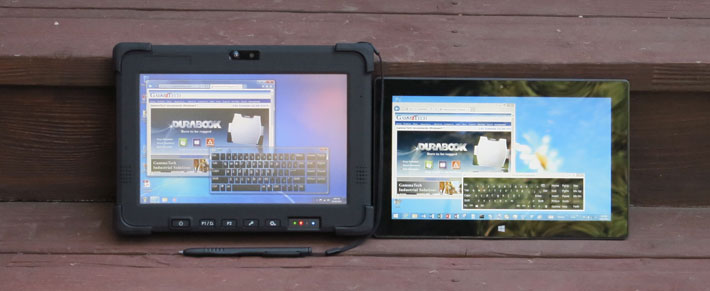
We observe the same characteristics looking at the two tablets from the right and then left side. In each case, the Surface tablet exhibits distracting reflections that can make the display unreadable. The CA10 screen remains readable, but there are diffused reflections that can also affect readability.
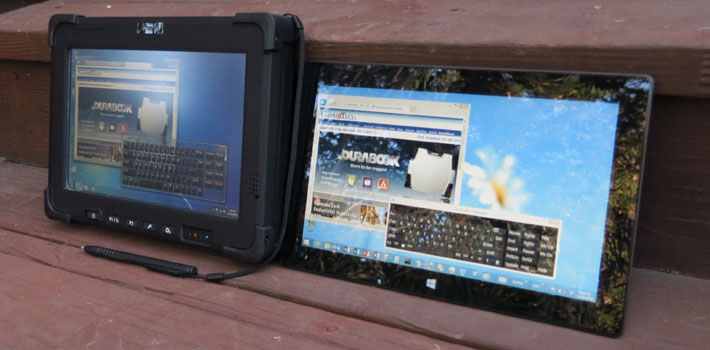
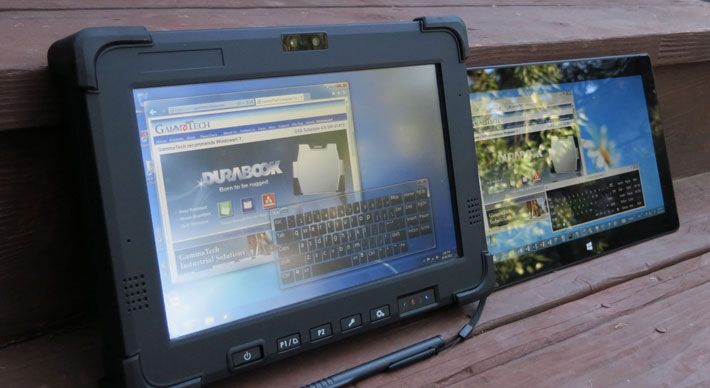
Below we're looking at the two displays from above. Here's the glossy RT screen isn't affected much by reflections whereas the CA10's narrow vertical viewing angle becomes quite obvious.

Overall, while the Durabook display doesn't offer the superior viewing angle of an IPS or AFFS display, its semi-matte display and solid reflection control does make it quite usable for outdoor work.
Ruggedness — probably exceeds specs
The name "Durabook" makes you think of qualities such as "tough," "durable," "reliable," etc. Unfortunately, there are no standards on what exactly defines "rugged" or "semi-rugged" or even "durable" or "business-rugged" or whatever else the industry has come up with. Even the often cited MIL-STD-810F and its successor, MIL-STD-810G, really only describe the procedures for a variety of environmental tests. What it means is that the terms are quite elastic. GammaTech is often inconsistent with its terminology, and that's no different with the CA10 that's sometimes referred to as "semi-rugged" and then as "rugged." Such inconsistency can be confusing to potential customers.
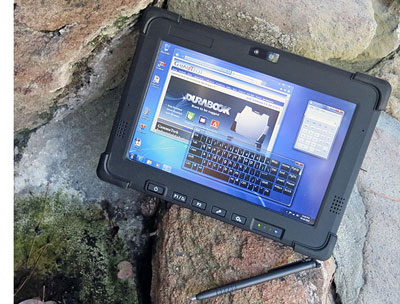 As is, GammaTech really only claims resistance to drops and vibration, and lists an operating temperature range. As is, GammaTech really only claims resistance to drops and vibration, and lists an operating temperature range.
For drops, testing is conducted in modified accordance with the procedures described in MIL-STD-810G, Method 516.6, Procedure IV. Drops are from a height of 48 inches onto 2-inch plywood over concrete. That is in line or better than other semi-ruggeds on the market.
GammaTech also states shock and vibration resistance in testing similar to MIL-STD-810G, Method 514.6, Procedure I, Category 4, Fig 514.6C-1 which simulates traveling in a truck on a highway for 1,000 miles, compressed into 60 minutes. In addition, also adherence to integrity exposure as shown in Fig.6E-1 in the same section, as well as ASTM4169, Truck Transport, 11.5.2 Random Test, Assurance Level II (ASTM stands for American Society for Testing and Materials. The D 4169 standard sets tests and requirements for strength, durability and protective capability of packaging. Level II stands for medium test intensities and is most commonly used).
On the sealing front, GammaTech claims IP43-level protection. The "4" means protection against solid objects over a millimeter in diameter, and the "3" means protection against water spray spray up to 60 degrees from vertical. What that means, is that the CA10 really doesn't offer much sealing and shouldn't be exposed to the elements, especially the backside where the ventilation slots are.
The operating temperature range is given as -4 to 113 degrees Fahrenheit (-20 to 45 centigrade), again just average by rugged computing standards (it often gets hotter than 113 outside of the RuggedPCReview.com office in Northern California in the summer).
As we've found in prior tests of Durabook computers, if you dig a bit deeper into enigmatic GammaTech's materials and origin, past the official specs, you'll find that the machine offers quite a bit of vibration protection (as is evident from looking at its insides with all its shock absorption and magnesium construction) and that it's really tougher than the few supplied specs might lead one to believe. And Twinhead, GammaTech's corporate mothership in Taiwan, has decades worth of experience making rugged computers—and not just semi-ruggeds, but also fully rugged and ultra-rugged ones (that's where the late General Dynamics Itronix notebooks came from).
As is usually the case with GammaTech gear, the Durabook CA10 also feels a lot tougher than its environmental specs suggest. It is definitely a sturdy machine, and a durable one that's exceptionally well made. The tablet definitely deserves more detailed ruggedness specs, and maybe they are buried somewhere on the GammaTech/Twinhead/Durabook sites. For some reason, there continues to exist a sizable gap between the consistent quality and performance of Twinhead/GammaTech products, and the modest and often confusing and somewhat inconsistent websites, documentation and overall low-key presentation of the company. It seems an easy thing to fix and would likely lead to more sales and a (well-deserved) higher profile.
Summary: The GammaTech Durabook CA10
The GammaTech Durabook CA10 is a hardened, fanless 3.5-pound tablet computer designed to be substantially tougher and more durable than standard consumer tablets, but without the high cost of a fully rugged model. It's a solid, trust-inspiring machine with a bright, reflection-free 10.1-inch wide-format display, good connectivity, good battery life, and more than sufficient performance.
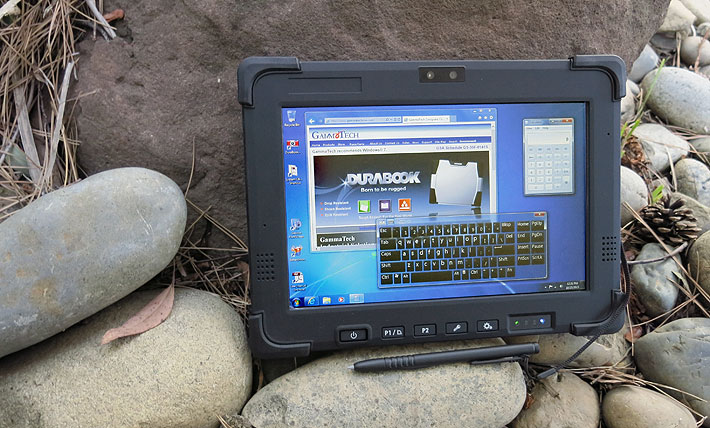
As is GammaTech's practice, the US$1,299 starting price of the Durabook CA10 is remarkably low compared to fully and even most semi-rugged tablets. That's for a bare-bones machine, of course—Durabook tablets are built-to-order and available with a wide range of configurations, modules and options that can quickly drive up the price.
Based on the economical dual-core Intel Atom N2600 processor, the Durabook CA10 is a good performer. Our review unit achieved above average overall benchmark results in its class. Between the combined 58 watt-hours of the dual hot-swappable batteries and the good power conservation measures, battery life is more than sufficient.
The Durabook CA10 has a bright 1280 x 800 pixel wide-format display that remains usable outdoors with very little reflection and glare. The resistive multi-touch screen can be used with gloves, in the rain, and also with a stylus.
While it's not immediately obvious from the modest ruggedness claims, the Durabook CA10 is a very solid and supremely well made tablet. Its magnesium alloy chassis should hold up for a long time, and there is plenty of shock-mounting as well as plenty of internal protection. However, keep in mind that this tablet is not waterproof (open cooling vents to inside on the back). Examine ruggedness specs to see if they match your requirements.
Overall, the amazingly affordable Durabook CA10 with its wide-format resistive multi-touch display and rock-solid construction is a good deal for anyone who needs a versatile, highly configurable tablet that is much tougher than any standard consumer tablet and should hold up well in daily use.
GammaTech Durabook CA10 highlights:
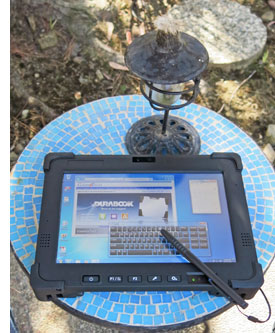
- Very solid and well-made semi-rugged tablet
- Solid performance with dual-core Intel Atom N2600 processor
- Bright 500-nit 16:10 wide-format display with decent outdoor viewability
- Display is not glossy and offers very good reflection control
- Resistive multi-touch screen can be used with gloves, when wet, and with a stylus
- Very solid magnesium-alloy chassis and very clean construction
- Low starting price
- Powerful 58 watt-hour dual batteries
- Fairly easy access to module/expansion compartments
- GammaTech does build to order (BTO)
- Fanless design
- Easily customizable for resellers
- Wealth of useful options (mag card reader, PIN pad, vehicle docks, scanner, etc.)
But keep in mind:
- Narrow vertical viewing angle
- Modest sealing (IP43), and few other environmental specs are provided
- Adding options can significantly increase the cost
- Hard to get solid, comprehensive data from company (various websites, inconsistent specs)
- Ventilation slots in the back can easily let water in
- No HDMI and VGA ports
– Conrad H. Blickenstorfer, October 2013
|
GammaTech Durabook CA10 Specifications
|
| Status |
Added 01/2013, updated 05/2013, full review 10/2013
|
| Product type |
Semi-rugged tablet computer
|
| Processor |
Intel Atom N2600
|
| CPU speed |
1.60Ghz
|
| CPU Thermal Design Power |
3.5 watts
|
| Chipset |
Intel NM10 |
| OS |
Windows 7 Professional |
| Graphics Controller/Chipset |
Integrated
|
| Memory |
2GB DDR3-800 SODIMM in one 204-pin slot |
| Display |
TFT LCD with LED backlight (optional sunlight-readable LCD)
|
| Display type |
TFT LCD; optional high-brightness TFT LCD (500 nits)
|
| Display size and resolution |
10.1" WXGA (1280 x 800 pixel)
|
| Digitizer/Pens |
Resistive multi-touch with tempered glass
|
| Keyboard |
Onscreen keyboard + optional external |
| Storage |
32/64/128GB m-SATA SSD |
| Multimedia Pocket |
NA |
| Slots |
1 x SD Card, 1 x SIM
|
| Housing |
Magnesium alloy chassis, plastic shell |
| Temperature |
-4° to 113°F (-20° to +45°C) |
| Humidity |
20 to 90% non-condensing |
| Vibration |
MIL-STD-810G, Method 514.6, Procedure I + ASTM4169, Truck Transport, 11.5.2 Random test, Assurance Level II |
| Sand and Dust |
NA |
| Explosive Atmosphere |
NA |
| Enclosure Class |
IP43 |
| EMI |
NA |
| Shock: Transit Drop |
26 4-foot drops per MIL-STD-810G 516.6 Proc. IV |
| Certifications |
US: FCC, DOC+, CUS, FCC ID; �EU: CE, CB; �CAN: CUS, IC |
| Size (inches) |
10.6 x 7.8 x 1.1 inches (270 x 198 x 41 mm) |
| Weight |
3.4 pounds (1.55 kg) as tested with dual batteries
| Power |
2 x Li-Ion 11.1V/2,600mAh/29 watt-hours, "6-7 hours" |
| Camera |
front: 1.3mp webcam; rear: optional 5mp with LED illuminator |
| Wireless |
Intel Centrino Wireless N135 (802.11b/g/n WiFi, Bluetooth v3.0 + EDR; optional: WWAN/GPS (AT&T, Sprint, T-Mobile) via mini PCIe module, RFID reader, MSR, 1D/2D scanner
|
| Interface |
2 x USB 2.0, 1 x RJ45 LAN, 1 x RS232, dock
|
| Price |
Starting at US$1,299 |
| Contact |
GammaTech |
| Website |
GammaTech Durabook CA10 page |
| Brochure |
 GammaTech Durabook CA10 brochure GammaTech Durabook CA10 brochure |
| Warranty |
2 years |
|
|






